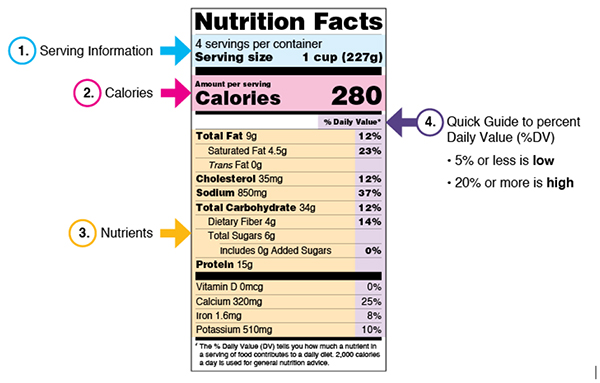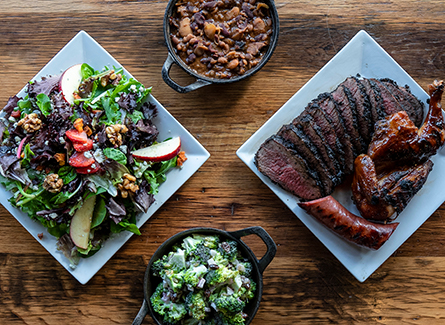
Trying to understand Nutrition Facts labels need not feel like code breaking. There are no secrets to reveal. What you see on every label is what you will get. By routinely reading what’s in packaged foods and drinks, you’ll make informed choices about what you consume. If you have a health condition with dietary requirements, such as diabetes or kidney disease, the labels will help you monitor your carbohydrate or sodium intake, respectively.
Each label contains product-specific information, including serving size, calories, nutrient information and the % Daily Value (%DV).
Serving Size
The label’s nutrient amounts, such as calories, carbohydrates and sodium, refer to serving size. Paying attention to serving size and the number of servings will help you stay on track.
In the lasagna example (see label below), one serving equals 1 cup or 227 grams. If you eat 2 cups, you will consume two times the serving size, so you would need to double the nutrient and calorie amounts and the %DV. In total, there are 4 cups in one container of the lasagna.
Please note serving size is not a recommendation of how much you should consume. This is just how the nutrients are calculated. For guidance, look to the MyPlate method as a great tool to create healthy well-balanced meals.

Calories = Energy
Calories are essential to keep the body alive. From breathing to running, we need energy to fuel the body for everyday movements. Consuming too many calories is one factor that can lead to weight gain.
Your individual needs will be higher or lower based on several factors. Depending on your activity level, age, height, medical condition, sex and weight, your calorie intake could range from 1200-2500 calories a day. So, a 280-calorie lasagna serving would amount to 23%-11% of your daily calories, depending on your caloric intake needs.
Fat
Fat is a slow burning source of energy. It’s needed to absorb several minerals and vitamins and increase fullness. The labels account for four different fats (it is not required that food labels list unsaturated fats):
- Monounsaturated
- Polyunsaturated
- Saturated
- Trans fat
The types of fats we eat affect the cholesterol levels in our blood:
- Saturated and trans fats increase the risk of heart disease. Generally solid at room temperature, they include butter, coconut oil, high fat meats, margarine and whole fat dairy.
- Unsaturated fats also help reduce the risk of heart disease. These are generally liquid at room temperature and include low-fat dairy, 1% or skim milk, low-fat yogurt or low-fat cottage cheese, but also avocados, nuts, oils and seeds.
To stay within the recommendation of 50 grams-75 grams of total fat daily, choose foods with fewer than the following per serving:
- Total fat: 5 grams
- Saturated fat: 2 grams
- Trans fat: 0 grams
The American Heart Association recommends 5%-6% of calories from saturated fat, which is about 13 grams of saturated fat per day.
Food labels can be sneaky. Products can be listed as “0 grams of trans fats,” if they contain less than 0.5 grams of trans fat per serving. You can also spot trans fats by reading ingredient lists and looking for ingredients referred to as “partially hydrogenated oils.”
Cholesterol
There is no need to look at cholesterol on food labels. Although cholesterol comes from animal products, the cholesterol found in animal products does not affect blood cholesterol. Rather, simple carbohydrates, saturated fats and trans fats affect blood cholesterol. The body needs this fat-like substance, but too much can increase your risk of heart disease and stroke.
Sodium
Sodium is an important electrolyte that we need to live, but too much sodium is not good. Even those who do not add salt to their foods may take in far too much sodium in processed foods.
To limit your sodium intake to 2,000 mg daily, keep in mind that 1 teaspoon of salt contains 2,300 mg of sodium. Per serving amounts of sodium for foods labeled are:
- Low-sodium foods: Less than 140 mg
- Very low-sodium foods: Less than 35 mg
- Sodium-free foods: Less than 5 mg
- Less, lower or reduced sodium foods: At least 25% less sodium
Carbohydrates
Healthy eating and proper nutrition play a big part in maintaining good health. Our registered dietitians work with you to set realistic and achievable goals. Our services are available to anyone who wants nutritional guidance. Ask your physician to refer you to North Kansas City Hospital’s Nutrition Counseling Program.
Carbohydrates primarily provide energy for the body, especially the brain and nervous system. Carbohydrates are macronutrients that are broken down into glucose, which affects blood sugar.
Carbohydrates come from beans, breads, corn, fruits, legumes, milk, pasta, peas, potatoes, rice, snacks, sweets and yogurt. However, dietary fiber and total sugars are also included in the total carbohydrate amount on food labels.
The three broad types of carbohydrates are fiber, starch and sugar. Regarding sugar, natural sugars include sugars naturally present in many nutritious foods and beverages. Added sugars include sugars added during the processing of foods.
-
Carbohydrate recommendation
- 45%-65% of calories
-
Fiber goal: 25 grams-35 grams daily
- Good source contains: 2.5 grams-4.9 grams per serving
- Great source contains: More than 5 grams per serving
-
Added sugar
- Men: Less than 9 teaspoons (36 grams) per day
- Women: Less than 6 teaspoons (25 grams) per day
- Consider that one 12-ounce can of soda contains eight teaspoons (32 grams) of added sugar.
Choose complex carbohydrates, such as beans, fruits, legumes and starchy vegetables (corn, peas, potatoes) because they contain more fiber, minerals and vitamins. Limit simple carbohydrates, such as candy, juice, soda, sugar, white bread and white pasta, because they contain fewer nutrients and are highly processed.
Protein
Protein is important for building lean muscle mass, repairing tissue, supporting a healthy immune system, regulating hormone levels and balancing enzyme production.
- Protein recommendation: 10-35% of calories
- Good source: 10 grams -30 grams per meal and snack
Choose lean proteins such as eggs, fish, lean beef (90%), pork chops, seafood, skinless chicken and turkey; loin and round cuts and trim visible fat; and plant-based proteins such as beans, chia seeds, flax seed, hemp seeds, lentils, soy (edamame, tempeh, tofu), nuts and seeds, nut butters and quinoa. Limit intake of processed meats such as bacon, bologna, deli meats, hot dogs, sausage and turkey sausage.
Vitamins and Minerals
Americans generally do not get the recommended amount of the calcium, iron, potassium and vitamin D. Diets higher in these can reduce the risk of developing anemia, high blood pressure and osteoporosis.
- Vitamin D foods: Eggs, dairy fish, seafood and vitamin D fortified products.
- Calcium: Calcium-fortified products and dairy
- Iron: Beans, red meat (beef and pork) and soy products (soy milk, tofu)
- Potassium: Fruits and vegetables
Percent Daily Value (%DV)
The %DV represents the entire day and is based on consuming 2,000 calories a day. You may need more or less than 2,000 calories per day. You also may need more or less than 100 %DV for nutrients. If there is no %DV, then no recommendation has been made for the total amount to eat in a day. For example, a food label with a 12% DV of fat provides 12% of the total fat for a person who needs 2,000 calories a day.
- Aim low in saturated fat, sodium and trans fats: 5% or less
- Aim high in dietary fiber, minerals and vitamins: 20% or more



